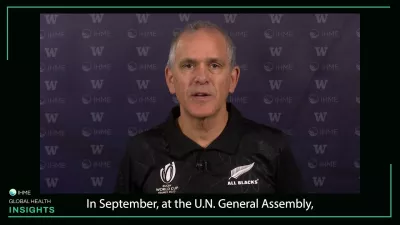In September at the UN General Assembly there was a second high level meeting on tuberculosis, and it was a reflection of the appropriate global attention on one of the major diseases, and, in fact, the leading infectious disease after COVID in the world today.
Now, the history around global action on TB goes back to the early nineties when WHO pointed out that there were directly observed therapies for TB that could be highly effective, and tuberculosis was making very slow progress at the global scale. The history around TB then was things got worse with the co-infection epidemic with HIV and the powerful interaction of decreased immune function with HIV and the resurgence of TB in HIV positives.
But in the era of ART for HIV and global action fueled by the Global Fund investments in TB programs, we have seen over the last two decades or more, a slow but steady decline in tuberculosis deaths about 4% per year in the GBD analysis. Now that progress on TB, which has been much slower than for HIV, at least since 2005, and the big scale-up of ART, and slower than for malaria with the scale-up of of bednets.
So amongst the three big diseases that were a focus in the MDGs and in the SDGs, TB has lagged behind. And then during the COVID epidemic, we've seen real issues emerge. We're not 100% sure of the myriad impacts of COVID. We know that people didn't seek care, and the numbers of people being diagnosed have went down abruptly during COVID.
We think that perhaps there was some decreased transmission during COVID because of social distancing and mask wearing, and it may have been that people with early clinical TB were actually being killed by COVID. And so that may have also contributed to the reductions in the number of patients being diagnosed. All in all, it will take a little bit longer for the data to come in to give us a clearer picture about what were the full impacts of COVID, but we know there was a powerful interaction.
The other concern has been around resistance to TB. Now, this is a long running concern in the TB community. Back in the nineties, there were great calls and concerns that drug resistant TB was on the rise. Good surveillance systems were put in place in some countries and that certainly helped us have better data.
And in the GBD analysis, what we see is that while TB deaths overall have been going down 4% per year in the last two decades, deaths that are about 10% due to drug resistant or multi or extremely drug resistant TB have been going down at only about 3% per year. So the share is slowly going up due to drug resistant TB.
Not an abrupt increase, but a slow, steady rise, up to about 10%, as I mentioned today. So we have a story around TB that it hasn't been keeping up with HIV and malaria in terms of progress, despite several decades of global attention and investment. And it means that if we want to see faster progress on the leading infectious disease now after COVID has subsided quite substantially, there needs to be new investment or further investment.
There needs to be, we hope, new tools. There's a number of things in development that show promise that we hope will mean that there are better vaccines, better drugs, shorter therapies that may be coming and perhaps new strategies or old strategies that have come back. For example, much more active screening is a possibility that needs to be further investigated and the evidence accumulated as to whether that will actually work.
But what we do know is that if we keep going on our current course, we should not expect accelerated reductions in TB. And in fact, there's enough concern about things like drug resistance, or the sort of issues that emerged during COVID in terms of diagnosis and people seeking care that it deserves concerted attention on tuberculosis. This is a concern that as new tools may emerge and we've had this slow progress on TB and we want faster progress exactly at a time when the funding for global health initiatives like the Global Fund for AIDS, TB, and Malaria, or domestic resources for TB programs are really under threat.
The debt crisis in low and middle-income countries and the shift of donor attention towards climate investments really will put under threat the global commitment to fund accelerated action for tuberculosis. But it clearly is a need, as we see it in the GBD analysis.

